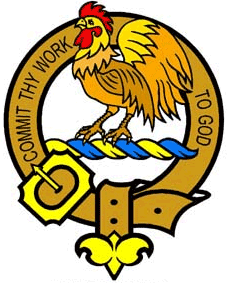Sinclair Clan
Sinclair Clan Crest: A cock proper.
Sinclair Clan Motto: Commit Thy Work To God.
History of Clan Sinclair/St Clair:
Sir William Saint Clair, son of Waldern de Saint Clair of Normandy, arrived in Scotland with Princess Margaret Atheling who became the second wife of Malcolm III. He was granted the Barony of Rosslin, south of Edinburgh,
and this was confirmed upon his son in 1180.
Henry St Clair, 7th Baron of Rosslyn, with his brother William, his son William, and his kinsman John St Clair of Herdmanston, and a Gregory St Clair, rendered homage to Edward I of England in 1296. However, in company with Sir Symon Fraser of Neidpath Castle and John Comyn, Earl of Buchan, he later won the Battle of Roslin against the English in 1303. Thereafter, the St Clairs fought for Robert the Bruce and in 1317 received a grant of the lands of Pentland as a reward.
Through his mother, Isabella Forteith of Strathearn, Sir Henry St Clair, 9th Baron of Rosslyn, became 42nd Jarl and 1st St Clair Prince of Orkney, owing allegiance not only to the Scottish Crown but to the rulers of Norway. From his castle in Kirkwall, he embarked upon several voyages, including one to the Faroe Islands and Greenland, and another to Nova Scotia (Estotiland) and North America.
His grandson, 3rd St Clair Prince of Orkney, had three marriages, the first to Lady Margaret Douglas, granddaughter of Robert III, by whom he had a son and four daughters, one of whom married the Duke of Albany, brother of James III. By the second marriage to Lady Marjorie Sutherland, a great-great-granddaughter of Robert I, he had six sons and seven daughters. After her death it is thought that he married for a third time, but the records are vague.
Apart from his building Rosslyn Chapel, two significant actions influenced the fortunes of the St Clair family during the tenure of Prince William. In 1455, he exchanged the earldom of Nithsdale, which he had inherited through his mother, for the earldom of Caithness. In 1469, following the marriage of James III and Princess Margaret of Denmark, the Orkney Islands were formally annexed by the Scottish Crown and William handed over the earldom of Orkney in exchange for Ravenscraig Castle and lands in Fife.
This meant that future St Clairs were ineligible to style themselves 'Prince,' and when Prince William died, his lands and titles were dispersed among his children, his eldest son by his first marriage acquiring the Dysart Barony, his eldest son by his second marriage acquiring Rosslyn, and the second son by his second marriage becoming 2nd St Clair Earl of Caithness.
It was at this time that the Caithness branch of the family began to spell their name Sinclair, although the Rosslyn branch continued with St Clair. The 2nd Earl of Caithness fought and died at the Battle of Flodden
with 600 Highland Sinclairs. His descendants thereafter were of a wild
disposition, the 4th Earl imprisoning and starving to death his own son for making peace with Clan Moray without his approval.
George, 6th Earl of Caithness, burdened with inherited debts, was obliged to sell off parcels of family land. He died childless in 1676, whereupon the Caithness title eventually passed to George Sinclair of Keiss.
The 19th Earl of Caithness (1906- 1965) was Commander-in-Chief of the newly independent Ceylon (Sri Lanka). Malcolm, 20th Earl of Caithness (1948-) served as Minister of State at the Home Office and Paymaster General in Margaret Thatcher's Government.
Sir William St Clair of Rosslyn ( d.1331), son of the 6th Baron of Rosslyn, accompanied Sir James Douglas on his expedition to Spain with the heart of Robert I. William St Clair (d.1337) was Bishop of Dunkeld. He crowned Edward Balliol and rallied Scots against the English attack on Dunfermline. John Sinclair (d.1566) officiated at the wedding of Mary Queen of Scots and Lord Darnley. George Sinclair (d.1696) was Professor of Philosophy at Glasgow University and was associated with the invention of the Diving Bell. He was author of Satan's Visible World Discovered. Sir John Sinclair of Ulbster (1754-1835) became President of the Board of Agriculture in 1798. Robert, 4th Earl of Rosslyn (d.1890) was Ambassador Extraordinary to Madrid. Sir Archibald Sinclair, 1st Viscount Thurso (1890-1970) was leader of the British Liberal Party from 1935 to 1945. He was Secretary of State for Air in the Churchill Administration.
Places of Interest:
Roslin, Midlothian. This picturesque village sprang up beside the 14th century castle and 15th century chapel, built by the St Clairs of Rosslyn. Rosslyn Chapel has recently attracted world wide interest from featuring
in the best-selling novel, The Da Vinci Code.
Castle of Mey, Caithness. Built in 1568 by George, 5th Earl of Caithness. It is today probably best known for having been the private home and retreat of Her Majesty Queen Elizabeth the Queen Mother.
Keiss Castle, Keiss, Caithness. Remnants of a small 16th century tower can be seen here. The 19th century castle nearby was the home of Sir William Sinclair, Founder and Pastor of the first Baptist Church in Scotland.
Noss Head, Wick, Caithness. The ruins of castles Sinclair (15th century) and Girnigoe (17th century) can be seen here. The estates were invaded in 1697 by Campbell of Glenorchy and both castles were destroyed.
Thurso Castle, Thurso, Caithness. Sir John Sinclair of Ulbster (1754-1835), the well known agricultural improver, lived here.
Surname distribution in Scotland: The Sinclair name is most commonly found in Highland (an amalgamation of the historic counties of Caithness, Inverness-shire, Nairnshire, Ross and Cromarty and Sutherland), The Shetland Islands (Zetland) and Orkney.
Associated family names (Septs): Budge, Clyne, Groat, Lyall, Wares.
Sinclair Clan membership prints.

